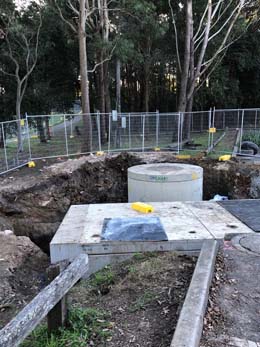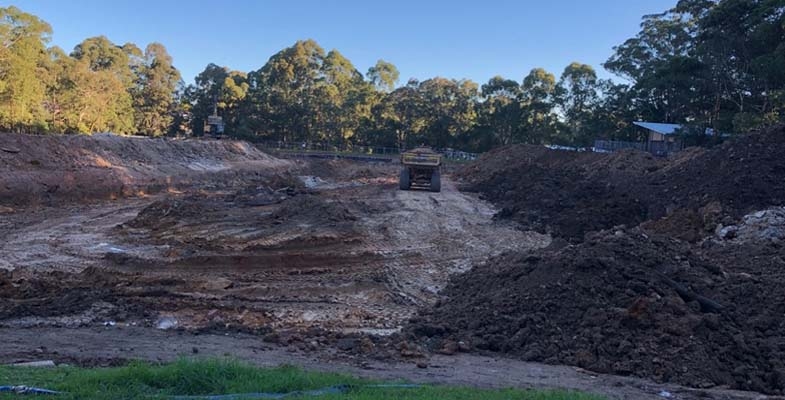A group of residents in West Pymble took Ku-ring-gai Council to the Land and Environment Court for a judicial review of the decision to proceed with the construction of a stormwater mitigation system and synthetic turf soccer field at Norman Griffiths Oval. A group called Natural Grass at Norman Griffiths (NGANG Ltd) was registered in order to conduct the case and receive community donations.
This follows council’s decision to proceed with the project in early March 2023 after the release of the Review of Environmental Factors (REF), version 8, two weeks earlier. The haste in starting work was a cause of much frustration in the community and a fiery public forum meeting. After all we had had to wait over 14 months to see the details of the design and the REF. The time available to review the REF was inadequate; much shorter than promised. The councillors dismissed the relevance of the environmental issues raised by the community on the grounds that the REF provided assurance that the issues were not significant.
An injunction was accepted by the court to stop construction past the stormwater mitigation system stage until the case was decided. The case was expedited so there would not be a long delay before contractors started laying the turf.
Over $120,000 was raised towards the costs of the case and expert witnesses. This is a demonstration of the high level of public interest and concern about the use of synthetic turf.

The gross pollution trap and diversion to underground detention ... but what about the water flow from the hill above the field?
Last minute amendment to the REF
NGANG was right! The time allowed to review the REF was too short. The REF was missing some of the analysis required about environmental impacts following an amendment to the Environmental Planning and Assessment Act 1979 (EP&A Act). Council decided it was okay to make a last minute amendments so version 9 was published on
4 July. Sadly, the L&E Court did not see that this expediency was an issue that could prevent the project proceeding but it is another demonstration of council’s poor governance.
Court case begins on 2 August
The main arguments submitted by NGANG were that:
Not all required environmental issues were considered to the fullest possible extent
The case was a judicial review where the relevant task is the consideration of the decision made by council. The judgement explained that a challenge may be made on the basis that the decision-maker should, acting reasonably, have made some additional inquiries. Expert evidence as to what the outcome of those inquiries would have been is, in some cases, admissible. Expert evidence was provided by Dr Scott Wilson, a microplastics expert and Dr Martens, a stormwater expert. Council also engaged three experts on flooding, pollution and ecology.
NGANG argued that council had not examined and taken into account to the fullest extent reasonably possible all matters likely to affect the environment following the installation of the synthetic turf. This is a duty imposed under section 5.5 of the EP&A Act.
NGANG’s case was that there should have been inquiries covering:
- a pollutant load study to assess microplastic pollution;
- a flood study to understand the flood impacts on the area and whether the stormwater detention proposed would function in the manner intended; and
- an investigation and understanding of where the overland stormwater flow path would be located in circumstances of an extreme rainfall (1 in 100 year event); and the investigation of the impact of the overland flow path upon the Sydney Turpentine Ironbark Forest below the field.
There was disagreement between NGANG’s expert and council as to the adequacy pf the onsite stormwater detention system (OSD). As an observer of the case, it appeared that much of the discussion of the OSD was at cross-purposes in referring to the existing system versus the new system. A new system had to be installed because the hard surface of the synthetic turf could not retain the stormwater. The old grass surface acted as the OSD.
The court ruled that the judicial review could not consider the merits of council’s decision and could only review whether it was acting reasonably. The judge rejected the evidence of Dr Martens and Dr Wilson that was sought to be tendered to establish the duty to make further inquiries in the circumstances of this case.
Stormwater system
Dr Martens advised on the requirement to undertake a study to understand the flood impacts on the area and whether the stormwater detention proposed would function in the manner intended. The report in the REF by Optimal Stormwater Ltd determined that the proposed system was capable of operating in the manner and to the specifications for which it was designed. The judge ruled that, in the circumstances, there was nothing on its face that would cause a decision-maker to consider that the opinions expressed were not reliable or not properly formed. The suggestion that the council was not entitled to take ‘at face value’ the information in the Optimal Report has no foundation. The question remains as to whether the specifications are adequate.
Microplastics
The ruling in relation to this issue indicates that the wrong question was being asked. On the evidence contained in the REF there is a goal of minimising microplastic loss from the synthetic field and identifies the measures to be adopted to achieve such goal. It is acknowledged that 100% capture is not possible, especially in extreme rainfall events but no further inquiries were recommended.
There is an obligation to commission an environmental impact statement
The other main ground argued by NGANG was the failure to comply with section 5.7(1) of the EP&A Act. This provision contains within it two obligations, first to determine whether the activity has a significant effect on the environment and secondly, if so, to not carry out the activity or grant an approval until it has obtained and considered an environmental impact statement (EIS):
In submissions NGANG formulated this ground on three bases:
- If the court found on the evidence that there was a prospect that the flood mitigation scheme being an integral part of the activity did not work as asserted by the manufacturer, either in not acting as an OSD system or not sufficiently capturing the overland flows, the court would find, on the evidence, that the proposal was likely to significantly affect the environment.
- If the court found on the evidence that the OSD system would not work as designed the infill and microplastics will not be sufficiently captured or retained on-site and will be washed down into the receiving environment, including Quarry Creek.
- A separate impact which has not been assessed from the overland flow path, which is the water diverting to the south over the field and then discharging into Quarry Creek, and the potential impacts on the adjoining STIF and Quarry Creek from that overland flow.
The judgement stated that consideration of significant impact on the environment is so broad and far reaching that it was unlikely to be determined as an objective fact by the court in judicial review proceedings. Therefore the question of whether an activity is likely to significantly affect the environment is not an objective jurisdictional fact but is a matter for the determining authority (the council) to determine acting reasonably. It seems that the precautionary principle doesn’t have any weight in this case whereby uncertainty does not justify inaction.
In this case the Judge found that council had acted reasonably. Statements by Dr Martens that the impacts may occur were insufficient to permit a finding of a likely significant effect on the environment. Modelling of changes in the hydraulic performance had not been done to enable the Court to make its own assessment.
Full steam ahead but what will happen when the plastic grass needs to be replaced?
So sadly, the construction of the synthetic turf field is now proceeding at maximum pace with completion possible by the end of this year.
The synthetic surface will not last forever, the lifetime with normal levels of use is 8 to 10 years. The question is, will council be able to replace the surface with synthetic turf? Now that a stormwater mitigation system is in place the flood risk from the field that acted as a stormwater detention basin has been substantially ameliorated. So it would be an excellent base for a natural grass field.
Currently there is no effective system for recycling the materials in synthetic turf so the large volume of material ends up in landfill. The evidence of environmental harm from the use of synthetic turf overseas is growing as is community opposition to its use because of the heat and injury risks. Several states in the USA have banned future installations of artificial turf because it contains dangerous chemicals such as PFAS compounds.
The Chief Scientist’s review into the design, use and impacts of synthetic turf in public open spaces highlighted the need for more research into human health and environmental impacts. Microplastics are a becoming more and more pervasive in our waterways. They can also interact with soil fauna, affecting their health and soil functions. Synthetic turf breaks down with people running over it and general deterioration from sunlight exposure. This breakdown increases as the turf blades age. The Norman Griffiths REF acknowledges that it is not possible to capture all the microplastics that will break off the turf. They will be washed off the field by rain but also blown away by wind due their small size of less than 5 mm.
We understand that council will be testing Quarry Creek for microplastics but the soil within the STIF forest and bushland below the field should also be tested.
The outcome of the chemical analysis must be taken into account when the replacement of the field surface is considered. Also we hope that the guidelines developed from the Chief Scientist’s review will provide meaningful decision making processes.
Ultimately the question that has to be asked is about the appropriateness of adding a large area of plastic to the environment when there is a viable natural alternative; that is real grass!
There has been such strong community opposition to synthetic turf at Norman Griffiths and in other parts of Sydney it will be difficult for councils to ignore in making future decisions.

